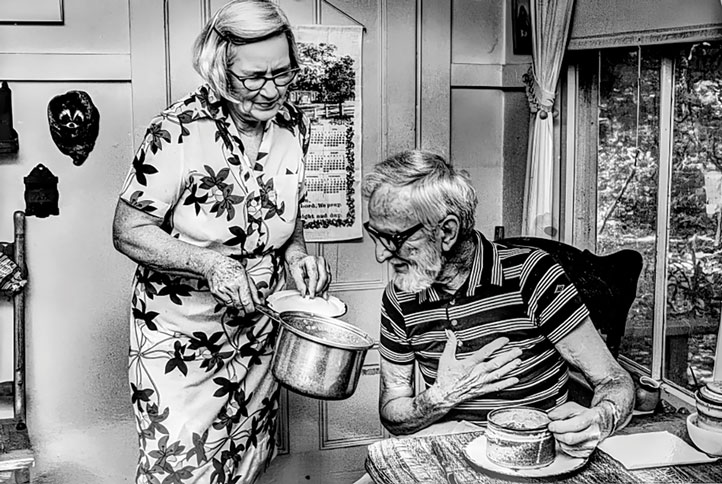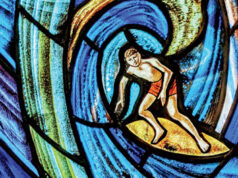by Tim Gilmore
Charlie Brown was 58 years old when he decided that his art, his creativity, could no longer come second, that it was time to leave his job as bookkeeper working 50 to 60 hours a week at Conway Produce Company. For too long, he’d relegated what mattered most to early mornings and late evenings, before and after work. His friends, even fellow artists, told him not to give up his financial security. He had no interest in retirement. “Charlie hadn’t sold but three or four pots when he quit his job,” artist Memphis Wood said in 1984. “I told him he wouldn’t make enough to buy his whiskey.” In 1977, Charlie told a reporter, “It was time I really did something constructive with the balance of my life.”

Rosemary McCorkle remembers when she met Charlie Brown. But she had to “pass” his sisters first. “Mandarin, when I first moved here in the 1960s,” she says, “was pretty stuffy.” People wanted to know if you lived by the river, or on the other side of Mandarin Road. The key to being accepted,” she says, “was if you could pass Charlie’s sisters.”
The Browns were an old Mandarin family, one of the earliest. John C. Brown had come to Mandarin from New York in the late 1820s. The 1880 Brown family home replaced the house he’d built a half century earlier. But the old gambrel-roofed house where Charlie and several of his sisters lived for more than 60 years had been The Palms Boarding House in the 1880s and was built for a Pennsylvania physician named Tweedle a few years prior. Charlie spent most of his time out back in his faded red wooden “pot shop,” as a 1974 newspaper article called it.
Charlie’s sisters were Harriet, the oldest, then Deenda, whose real name was Adaline. Then came Eleanor. Then Elizabeth, Mary and Fannie. Charlie was born between Elizabeth and Mary. When Rosemary arrived at the Brown siblings’ home for tea, she says, “I made a big social faux pas. I brought my children. I could see the look of horror on their faces when they opened the door.” The children behaved, however, and “one of the ladies” broke a teacup.
From 1962 to ’64, in the two years after Charlie left accounting, he handcrafted hundreds of wind-bells and chimes. He’d begun painting in 1940, working with terracotta sculpture in 1951, made scores of tall gray, green and black bottles in 1955 and ’56, then molded large open bowls and pots incised with angular and stick forms like those found in ancient handicrafts. It was raku ware that made him famous. Raku is a Japanese method he’d learned in 1964 from Hal Riegger, an “itinerant potter” who taught classes as he wandered through Florida.

Charlie avoided the pottery wheel, because the objects that came off it were “too perfect.” He used his hands instead. He dug his own clay. “Raku ware is taken from the kiln while still red hot,” Jacksonville Journal art critic Elihu Edelson explained on May 15, 1969, “and then thrust into combustible material like dried vegetation or sawdust. This blackens the clay and causes unpredictable glaze qualities.” Raku is difficult because the clay is so thin, light and soft.
“I love clay!” Charlie says in a 1969 retrospective program, “the way it looks—the way it feels when I mix it with my hands—the first glimpse of a glowing pot when the kiln is opened. I even enjoy the back-breaking task of digging it. I suppose, then, that it is perfectly natural that I have become so absorbed with the making of clay objects that it has become my very life.”
Then came the tragedy. Between two and three in the morning on January 28, 1978, a fire ignited from an errant spark in the sawdust. It destroyed his workshop, his kiln, his collection of art by his friends and his own pottery. By 10 AM, fellow artists of the Crown Craftsmen group had heard the news. They brought him comfort and clay and tools. Monday morning, architect Bob Broward stopped by and said, “Charlie, I’m going to design you a new studio and we’ll get people to build it. The only cost to you will be materials.” Fellow artists helped remove the rubble and burnt timbers and laid the new foundation. The following month, he created 30 new pots and bowls.
Charlie was 82 when he died in 1987. In 1991, the Mandarin Community Club tried to raise the funds to purchase the house Charlie and his sisters had lived in so long, but a developer named Daniel Copeland demolished it. Fannie Brown died in 1989, 79 years old. She’d lived on in the house by herself, but never set foot in Charlie’s studio, which had been sealed since 1984. Eleanor, the last Brown sibling, lived at a nursing home. When Charlie’s friends finally entered his studio, they cleared away cobwebs and found a handful of notes, a bottle he’d made in 1951, but very little of his own work.
What they found instead was a dust-covered museum of two dozen or more works by Jacksonville artists, including ceramic works by Nofa Dixon and Vina Schemer and paintings by Memphis Wood. For potters, wrote Cynthia Parks of The Florida Times-Union, Charlie’s studio had been like “the riverfront to cane-pole fishermen.” Friends recalled Charlie as “the nucleus, the father of the art scene here, helping start Florida Craftsmen, plus a crafts co-op” and Craftsmen Gallery on University Boulevard. Charlie kept “no trade secrets.” They called him a “giving man” who shared ideas and recipes for glazes.
Wherever Charlie Brown’s art can be found, in a couple dozen books, in old magazines ranging from Ceramics Monthly to Newsweek, at the Johnson Wax Collection in Washington, D.C., now part of the Smithsonian, in museums and private collections, Charlie’s “very life” resides still, in the earth he dug and fired and breathed life into here beside the St. Johns River.




